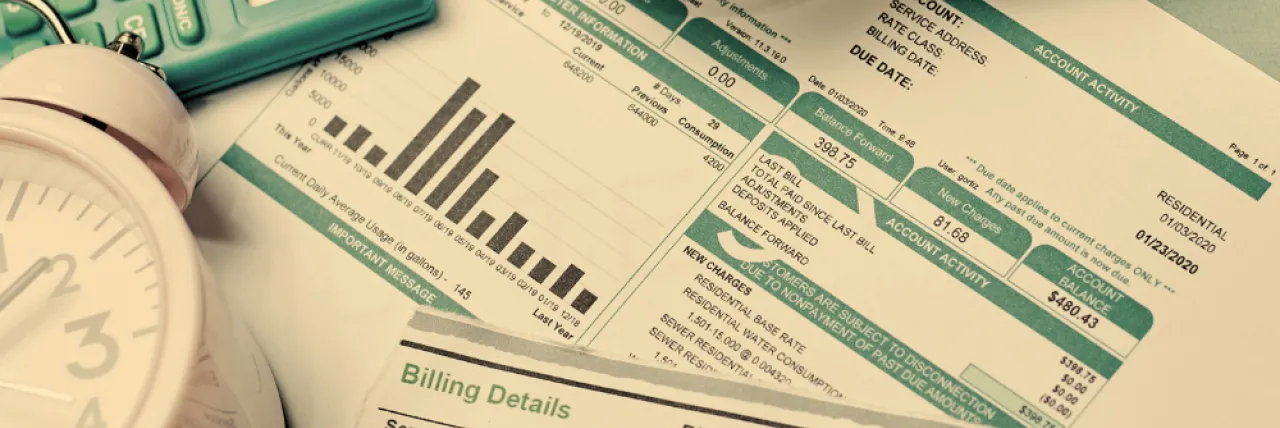Main Types of Charges
Service Charge
The service charge is the flat monthly fee you pay every month for access to energy. These are fixed charges – so even if you don’t use any energy, you’ll still be charged this flat fee. Service charges vary by utility.
If you receive electric service from a cooperative utility, or live in a rural area, service charges may be significantly higher due to the higher cost associated with serving a low population density.
Energy Charge
The energy charge on your bill is the cost of energy used, measured in kilowatt-hours (kWh) for electricity service or therms for natural gas service. Your utility will assess this charge by reading your meter.
While service charges are fixed, energy charges are variable. To reduce energy charges, change your energy usage patterns and identify energy waste in your home.
Energy rates may vary by season; electricity rates are often higher during the summer when demand is higher, and lower during the winter.
Most utilities have flat rates: they charge the same per unit of energy regardless of how much you use or the time of day. However, some utilities allow customers to opt into other types of rates, or even default customers to different rates. For example, time-of-use rates vary throughout the day, with high rates during peak use times (usually evening hours) and low rates overnight.
Riders
Riders are charges for specific aspects of your utility service, like the cost of fuel, or to cover energy program costs, like state-mandated energy conservation programs. Riders can vary based on usage or can be a flat monthly fee. Because some riders are variable charges, reducing your energy usage can further reduce your bill.
Taxes
Taxes on your bill vary based on where you live. All utility bills will include state taxes, and some will include local and county taxes. Some cities include franchise fees and other taxes on your bills as well. Most cities will only include variable taxes on their bills, but some cities issue flat fees.
Per state law, the primary fuel type that you use to heat your home from November 1 to April 30 is exempt from sales tax. “Primary” is defined as “the source which supplies more heat than any other source for the largest period of time during the heating season.”
Rates & Your Utility
Investor-Owned Utilities (“IOUs”)
Rates for investor-owned utilities are set and approved by the Minnesota Public Utilities Commission.
IOUs are corporations with shareholders who benefit from any profits.
Minnesota IOUs include: Xcel Energy, CenterPoint Energy, Minnesota Power, Minnesota Energy Resources, Otter Tail Power, Great Plains Natural Gas, and Greater Minnesota Gas.
Municipal Utilities
Municipal utility rates are regulated by city councils or locally appointed commissions.
Municipal utilities are non-profit, public entities.
Rochester is the state’s largest municipal utility. Customers in more than 100 Minnesota communities receive electric or gas service through their city.
Cooperative Utilities (“Co-ops”)
Cooperative utility rates are set and governed by a board of directors elected by its members.
Co-ops are member-owned nonprofit organizations. Co-op service territories cover over 80% of Minnesota, mainly in rural areas, and supply over 20% of Minnesota’s electricity.
Co-ops can opt to have their rates set by the Minnesota Public Utilities Commission. However, only the Dakota Electric Association, which serves portions of Dakota, Goodhue, Scott, and Rice counties, has chosen to do so.
Other examples of co-ops in Minnesota include: Connexus Energy, Lake Country Power, East Central Energy, Wright Hennepin Cooperative Electric, and dozens of others.
Things to Know
The world of energy billing is complex, but we have you covered. See below for some common questions and concerns. Contact us today with any specific questions you may have.
How would you know if you’re overpaying? For reference, the average Minnesota household uses about 750 kWh of electricity each month. If you use significantly more than this, and there’s not a simple explanation (such as having a large household or electric heat), chances are you can find ways to become more efficient and save money.
It’s more difficult to determine a typical natural gas bill. An average household may use about 75 therms of gas each month, but actual usage can vary from the average depending on the size and efficiency of a home, the temperature outside, and other factors – and bills can fluctuate drastically depending on the price of gas on the national market. Gas bills are generally much higher than average in the winter and lower in the summer.
If you think you pay too much for your utility service, you’re welcome to reach out to CUB. We can help you sort out any concerns and find ways to reduce your bills.
Electric heat rates
For those that use electricity to heat their homes, these rates may be a better fit and reduce energy costs. They are also exempt from taxation during the heating months.
Dual-Fuel rates
These rates are typically available for customers who heat with electricity but also have a secondary system to rely upon. In exchange for a lower electric rate, the utility may automatically shut off customers’ electric heat during periods of high electricity demand in order to control system costs.
Time-of-Use rates
This type of rate varies its charge per kWh based on the time of day. Peak usage periods will have higher charges. Low use times (usually overnight) will be noticeably cheaper. Households that can modify their usage to take advantage of lower cost times have the opportunity to save on their utility costs.
Electric vehicle rates
If you have an electric vehicle, check to see if your utility has an attractive rate for charging. This may require a separate electric meter and often provides highly discounted rates for charging overnight. When considering an electric vehicle rate, consider the amount of charging you do and the costs associated with a separate meter, if required.
Per state law, the primary fuel type that you use to heat your home from November 1 to April 30 is exempt from sales tax. “Primary” is defined as “the source which supplies more heat than any other source for the largest period of time during the heating season.”
Natural gas is one of the most common ways to heat a home in Minnesota, so many utilities assume that’s how you heat your home. If you use electricity or another fuel source to heat your home, check your bill and speak with your utility to make sure you aren’t being taxed inappropriately.
If you have been charged sales tax on your heating fuel type, you may be eligible for a refund. Discuss this with your utility and ask that the utility request a sales tax refund on your behalf.
Propane, wood, fuel oil, steam, and hot water sold to residential customers is exempt from sales tax year-round.
Billing errors, while rare, do sometimes occur. Utilities can bill you for an undercharge or refund you for an overcharge. Learn more here.
Renters may not have as much control over their energy usage as property owners, but they still have unique opportunities to take control of how they use energy. Learn more here.
Get Help with Your Bills
CUB is here to help you understand your utility bills and your rights. We help households navigate disconnection to maintain or reconnect utility service.


